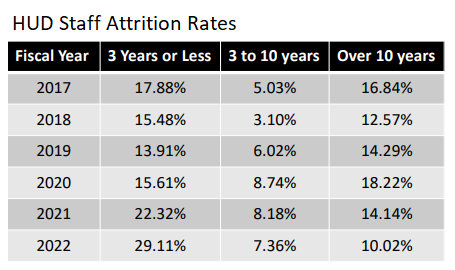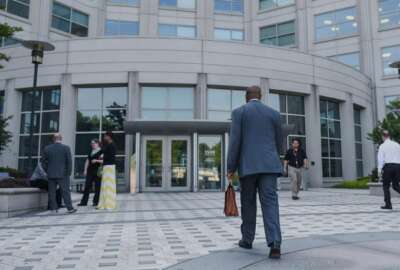
After OMB’s updated telework guidance, federal unions emphasize role of collective bargaining
Union leaders have emphasized that collective bargaining agreements already in place outweigh OMB's latest telework memo, but AFGE's chapter representing HUD em...
As agencies try to decipher what the White House’s latest guidance will mean for telework going forward, federal unions are urging against potential increases to in-office work for federal employees.
Union leaders have emphasized that bargaining agreements already in place outweigh the Office of Management and Budget’s April memo on organizational health and performance.
“The administration’s new guidance on agency work environments does not override collective bargaining agreements in effect at the agencies where we represent frontline employees,” National Treasury Employees Union President Tony Reardon said in a statement last month. “This means that for the vast majority of our members, their access to telework — which varies among agencies and types of jobs — will remain unchanged.”
OMB last month called on agencies to start measuring workforce productivity, and adjust telework levels as needed. Agencies should ensure telework remains “an important tool in talent recruitment and retention,” but also “substantially increase meaningful in-person work at federal offices,” OMB said.
Notably, OMB said as agencies develop their performance metrics, they should work with federal counterparts and stakeholders, including federal customers, employees and unions. Previous OMB guidance from 2021 also instructed agencies to honor existing collective bargaining agreements and work closely with labor partners to plan for any changes to work environments.
Federal unions have consistently favored telework as a workplace flexibility, where possible, to better recruit and retain federal employees. As a result, OMB’s guidance has become grounds for unions to reinforce their calls to maintain telework agreements established through collective bargaining.
“NTEU will continue to work with the administration and agencies to increase telework where appropriate and will strongly oppose efforts to scale back telework opportunities for frontline federal employees who are eligible,” Reardon said.
The American Federation of Government Employees has expressed support for the April OMB memo, at least in the areas that it says to maintain telework opportunities for federal employees. The union pointed to collective bargaining agreements at several agencies that have increased telework from pre-pandemic levels, which AFGE said helps agencies recruit and retain talent, be more productive and effectively deliver on their missions.
“We look forward to continuing to participate in that process at the appropriate level and reaching agreements that meet the operational needs of federal agencies,” said AFGE National President Everett Kelley in a statement last month.
But some agencies are receiving pushback from union chapter leaders over concerns that telework levels may decrease. AFGE chapter 222, which represents employees at the Department of Housing and Urban Development (HUD), is urging the agency to increase telework and remote work options amid high staff attrition.
Similar to union leaders, Salvatore Viola, president of AFGE chapter 222, said the OMB memo should not change the collective bargaining agreement already in place between HUD and AFGE.
“This is all guidance. It’s not regulatory. It’s not in law,” Viola told Federal News Network. “Even if it was, the agency still is bound by the provisions of our contract.”
At the same time, HUD “has made it clear that they want employees to return to the office,” Viola said in an April press release. “Employees don’t want to stay when they can find better paying jobs with more flexibility elsewhere.”
HUD does have a “flexiplace” program in place, developed in tandem with AFGE. Like many federal agencies’ policies, the program offers eligible employees eight telework days per pay period, remote work schedules and mobile work for those who travel regularly.
“We’re committed to the workforce, and really committed to the employee experience. We respect the union role as a part of that, and are in active conversations with the union, through our regular order and our regular processes with them. That is certainly an open line,” HUD’s Assistant Secretary of Administration Elizabeth de León Bhargava told Federal News Network.
Although HUD has no current plans to alter its flexiplace program, Viola said agency managers have been preemptively denying employees’ flexiplace applications to work remotely. AFGE brought the issue to the Federal Labor Relations Authority last year, and the case is still pending.
“If the agency goes ahead and tries to implement something that goes against our contract, we will be filing charges again, and we will be going to arbitration again,” Viola said.
Viola added that the reportedly limited remote work opportunities are causing high attrition rates, specifically for newer HUD employees. HUD is currently losing almost one in three new hires before they hit the three-year mark with the agency. Employees who had been at the agency fewer than three years had an increasing attrition rate between fiscal 2021 and 2022, going from 22.32% to 29.11%.

Looking more granularly, though, HUD officials said the attrition numbers are generally starting to improve. The agency’s voluntary, non-retirement attrition rate was 4.16% in fiscal 2022, while it was 5.1% in 2021.
“It’s a small reduction [in staff attrition], but it’s a reduction that is significant nonetheless,” Bhargava said. “Right now, globally, people are leaving jobs more frequently across the country and across government. Comparing pre-COVID levels to current levels is not an apples-to-apples comparison because we’re just in a new world.”
Attrition rates for employees who have been with the agency longer are also improving.

To try to get more feedback from employees on engagement and satisfaction, HUD created a small-scale “stay survey” for employees leaving the agency. It received 65% positive ratings from respondents. The pilot was primarily a way to assess the value of the questions and make changes before rolling out the survey on a larger scale, HUD Deputy Press Secretary De’Marcus Finnell said in an email to Federal News Network. HUD plans to use upcoming focus groups on the survey to make additional changes to the final version.
But Viola took issue with the way the survey was conducted, saying that the lack of questions about attrition, and asking why employees were choosing to leave, made the survey a limited resource to understand the root of the problem.
The 2022 Federal Employee Viewpoint Survey showed some satisfaction score improvements at HUD over the last decade.
“We are seeing record levels of engagement and satisfaction scores from FEVS, which is a much more robust tool for measuring employee engagement and satisfaction, than the pilot stay survey,” Bhargava said.
HUD is working on other employee engagement initiatives, including wellness activities, talent development programs and encouraging feds to join employee resource and affinity groups, Finnell said.
“HUD continues listen to our workforce as we look for areas to improve and continue to build a more diverse leadership,” Finnell said. “This is a key part of the goal to improve employee engagement in the federal workforce.”
Beyond HUD’s internal FEVS scores, though, Viola said it’s just as important to look at the results compared against higher-performing agencies in the survey, especially as competition increases as employees turn to agencies that are more telework friendly. He said this type of comparison shows all the more reason to further increase telework and remote work opportunities at the agency.
“It’s not about sitting in an office,” Viola said. “It’s about increasing the staffing resources necessary to get the work done.”
Copyright © 2024 Federal News Network. All rights reserved. This website is not intended for users located within the European Economic Area.
Drew Friedman is a workforce, pay and benefits reporter for Federal News Network.
Follow @dfriedmanWFED
Related Stories





